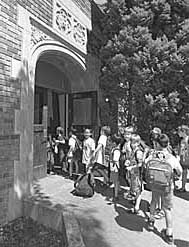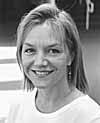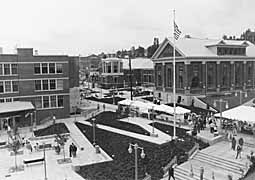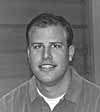
For the state and the UW, a steep climb in demand for higher education has begun.
 The class of 2012: When it's their turn, will there be room? |
In these numbers, state forecasts are becoming facts. Demand for higher education is growing. The reasons are clear:
In 1995 the state's Higher Education Coordinating Board (HECB) set a goal of increasing the system's capacity by 84,000 full-time-equivalent students (FTE's) by 2010. For the University of Washington, that goal translates as follows:
| UW Enrollment, Current and Projected, in FTE's | ||
| 1997-98 | 2009-10 | |
| Seattle | 32,004 | 38,410 |
| Bothell | 805 | 6,345 |
| Tacoma | 848 | 7,745 |
| Total University | 33,658 | 52,500 |
Getting from here to there requires careful planning and steady, year-by-year progress.
 UW Bothell: The Right Stuff
UW Bothell: The Right Stuff
With interruptions for four children, Marysville resident Angela Druckman earned a degree from Everett Community College and then looked around for a place to continue her studies in computer science. Long commutes and high tuition were not options: "I'm willing to make sacrifices, but there's a certain priority when you have a family." By happy coincidence, the UW Bothell program in computing software and systems was just being launched, and Angela became one of its first students. "For me, it was just right. There's an excellent blend of academic stuff and real-world stuff--we're always asking, `How can I use this?'" With one more quarter to go (which will also be her son's first quarter in the program), Angela plans to find a job in one of the local high-tech firms: "In systems analysis--the area I enjoy--you don't have the luxury of thinking narrowly. Because the program here is so broad, I've had a chance to hone all those skills." |
These are the principles behind the UW's 1999-2001 budget request for enrollment growth. Over the two-year period, we propose adding 1600 new FTE students.
At the undergraduate level, the UW would add 500 FTE's in Seattle, 240 in Bothell, and 300 in Tacoma. Seattle would increase access to such high-demand majors as computer science and engineering and business administration. Bothell and Tacoma would grow all their programs, adding (in Bothell) a day component to the computing and software systems program and (in Tacoma) a new business concentration in information technology.
 UW Tacoma |
At the graduate level, enrollment would increase by 400 FTE's in Seattle, 60 in Bothell, and 100 in Tacoma. Seattle would expand access to several high-demand professional master's-degree programs. Bothell expects growth in its Master's in Education for teachers, and Tacoma will add a Master's in Management/Leadership.
The past two legislatures have funded increased UW enrollments to help meet the state's access challenge. Even so, admission to the UW is growing more competitive.
Because more freshmen than expected enrolled in 1997, the class admitted in 1998 had to be smaller to fit within biennial funding limits. With applications up and class size down, the UW had to turn away students who in previous years would have made the cut. Last year, an "Admissions Index" (derived from high-school grades plus test scores) of 60 guaranteed admission for state residents; this year the number was 66. Unless the state invests in steady enrollment growth, getting into the UW will keep getting harder.
Educated citizens are the state's greatest resource. Growing this resource benefits everyone--the individuals who gain opportunity and fulfillment, the society that flourishes from their achievements. The demand for education is there. The UW requests funding to take the next step in meeting that demand.
 Paul Elery grew up in Tacoma, went away for college, and came back to
teach fifth grade at Brookdale Elementary School. When he was ready for a
master's degree in education, the goal wasn't just a credential but
"making myself a better teacher--broadening, sharpening, fine-tuning my
teaching skills." Brookdale Elementary, near McChord Air Force Base
and Fort Lewis, serves a mainly low-income and highly transient student
population, and Paul wanted help with the challenge of teaching these
kids. A colleague who'd just earned an M.Ed. at UW Tacoma gave it high
marks, and Paul and another Brookdale teacher went through the program
together. "It was amazing--way better than my undergraduate work.
There was more intellectual content and a more practical orientation. We
were applying things in the classroom right from the start." Paul's
enthusiasm has now brought another Brookdale teacher--the fourth in this
small school--into the M.Ed. program at UWT.
Paul Elery grew up in Tacoma, went away for college, and came back to
teach fifth grade at Brookdale Elementary School. When he was ready for a
master's degree in education, the goal wasn't just a credential but
"making myself a better teacher--broadening, sharpening, fine-tuning my
teaching skills." Brookdale Elementary, near McChord Air Force Base
and Fort Lewis, serves a mainly low-income and highly transient student
population, and Paul wanted help with the challenge of teaching these
kids. A colleague who'd just earned an M.Ed. at UW Tacoma gave it high
marks, and Paul and another Brookdale teacher went through the program
together. "It was amazing--way better than my undergraduate work.
There was more intellectual content and a more practical orientation. We
were applying things in the classroom right from the start." Paul's
enthusiasm has now brought another Brookdale teacher--the fourth in this
small school--into the M.Ed. program at UWT.
|